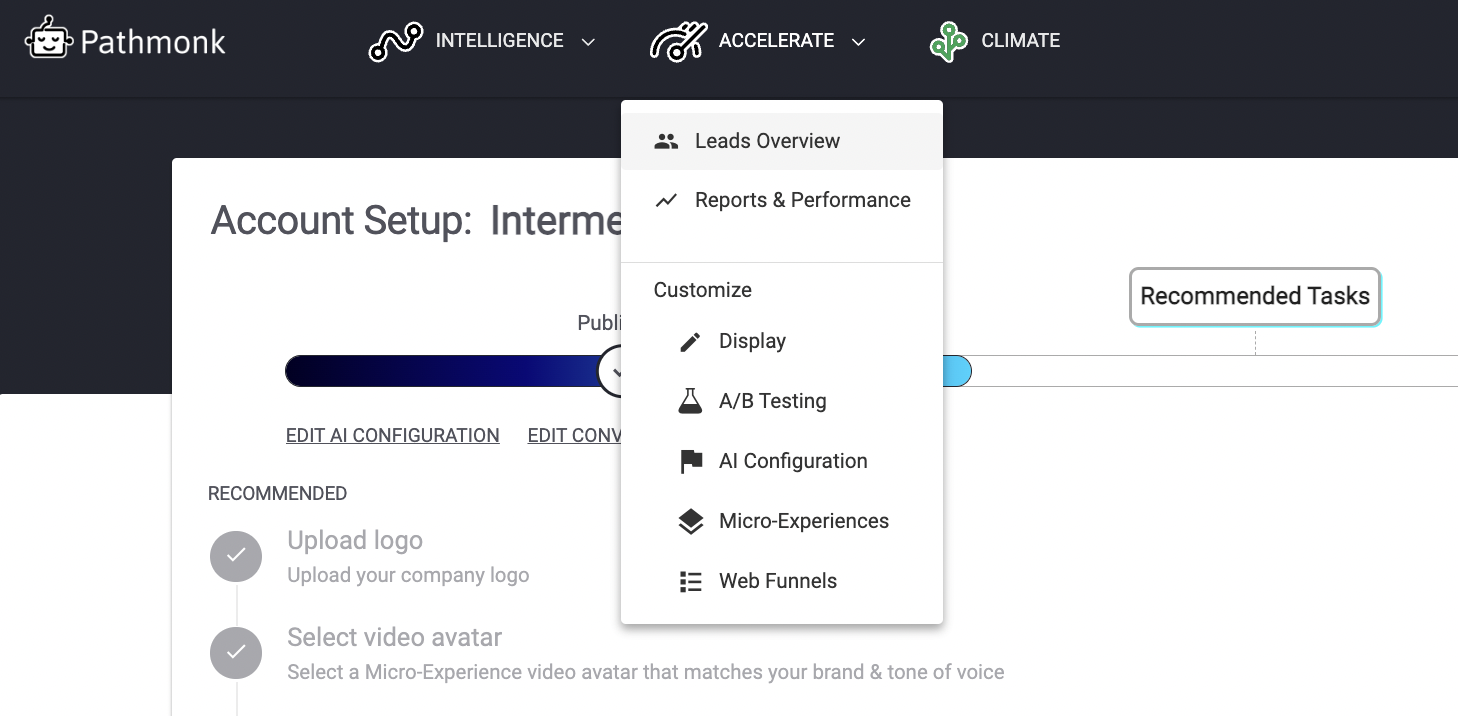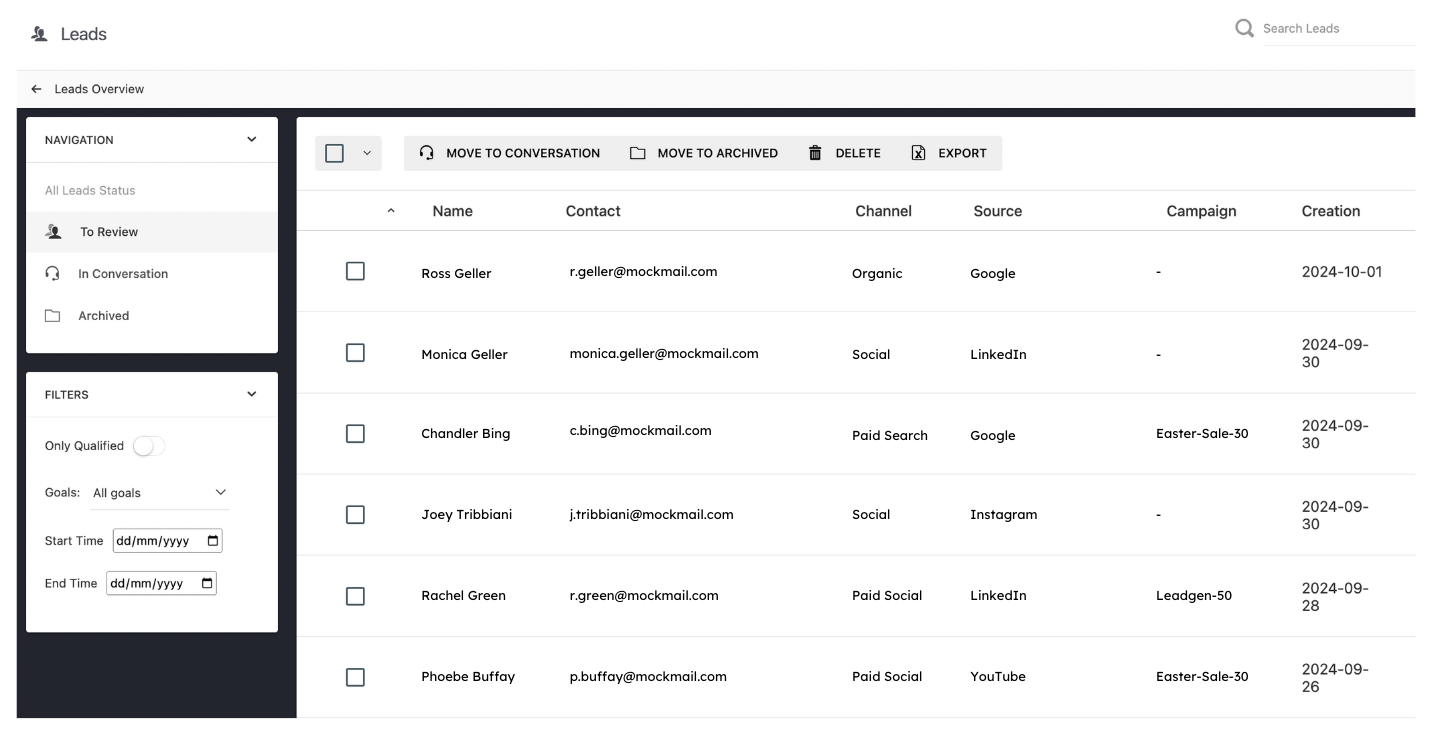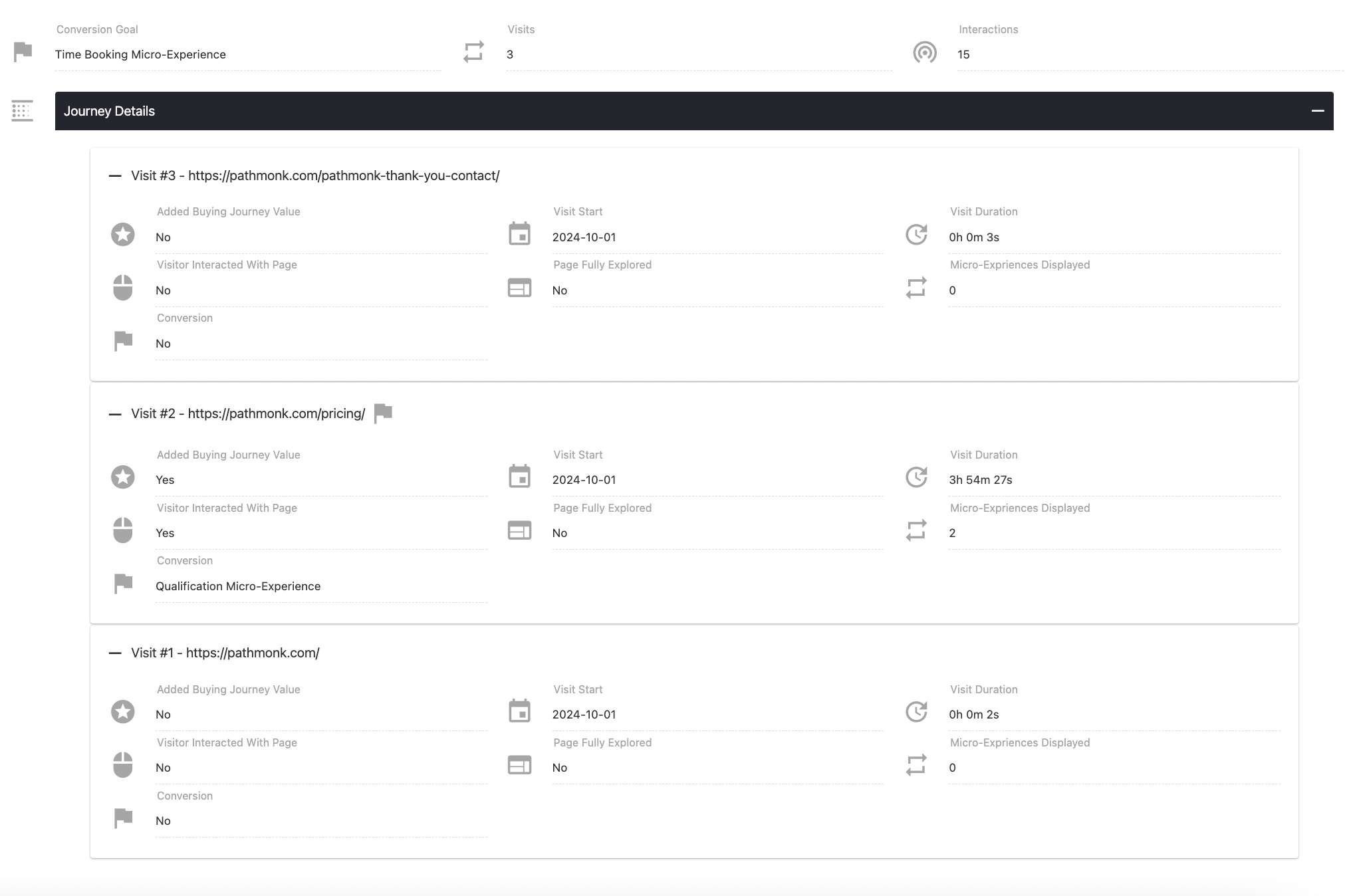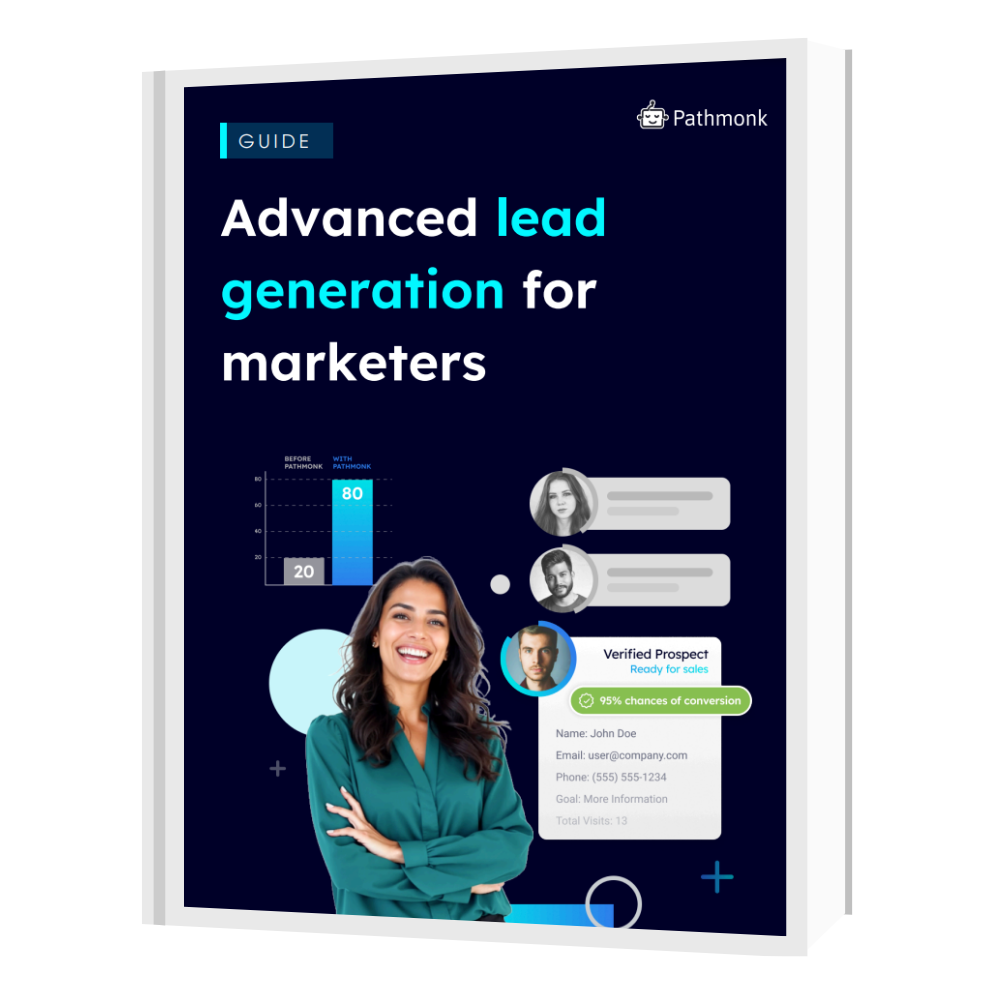Imagine two people visiting your website. Both leave their contact details, but their value as prospects couldn’t be more different:
- Person A 🧑🚀spends over 10 minutes exploring your product pages, reads through customer reviews, and interacts with your pricing section. After this, they submit a request for a demo. Their actions show clear buying intent—they’re engaged, informed, and ready to take the next step.
- Person B 👨💼, on the other hand, briefly scans your homepage and fills out a generic contact form within 30 seconds. Although they’ve left their information, their level of interest remains unclear.
The difference between these two visitors is intent. While both have shared their details, only Person A exhibits the high level of intent that’s more likely to lead to a sale.
But, guess what? Most lead generation tools will show you both visitors as equal opportunities. You get a name, an email, maybe even a phone number, but what’s missing is the deeper insight into their actual intent. Traditional methods treat every lead the same, flooding your sales team with unqualified prospects and wasting valuable time and resources. Without the ability to distinguish between these two, you risk chasing leads that aren’t ready, while missing out on nurturing the ones that are.
Let’s put an end to this misery with Pathmonk, shall we? ✨
By analyzing behavioral data in real time—like how long a visitor spends on key pages, what content they interact with, and how often they return—Pathmonk identifies high-intent leads and tells your Sales team where they should focus their efforts, boosting efficiency and results (and happiness too).
Table of Contents
Step by step: finding high-intent leads with Pathmonk
Once you’ve implemented Pathmonk, you’ll start receiving a steady stream of leads directly into your CRM of choice. Pathmonk integrates seamlessly with any marketing automation tool out there, allowing you to view and manage leads in a way that suits your workflow.
While visualization will depend on the CRM you’re using, you can always choose our own leads manager which is what we’ll show you in this tutorial.
1. Access your Leads Manager
First, log in to your Pathmonk account. Under the ‘Accelerate’ menu, select ‘Leads Overview’ and then click ‘Open Leads Manager’ to dive into the details.

Here, you’ll find all your captured leads, along with essential information like:
- Email address
- Acquisition channel (where they first interacted with your business)
- Source (whether organic, paid ads, social, etc.)
- Campaign (the marketing initiative that brought them in)
- Date of creation (when they first became a lead)

2. Check each lead’s intent score
For a more detailed view, click on any lead to access their Customer Journey Details. Pathmonk tracks their behavior across your website, providing a breakdown of key actions like:
- Pages visited
- Time spent on each page
- Specific interactions with content (e.g., clicking a pricing page, watching a product demo)
- Number of return visits

Each lead is automatically assigned a % of Intent score, calculated by Pathmonk’s AI. This score is based on real-time behavior, frequency of interactions, and engagement with high-conversion elements, such as your product pages or demo requests.

3. Prioritize and segment your high-intent leads
With the intent score in hand, you can now easily segment and prioritize leads. High-intent leads—those with higher scores—can be moved to the top of your sales funnel, while lower-intent leads can be nurtured further with targeted email campaigns or personalized offers.
Pathmonk’s insights ensure that your sales and marketing teams spend their time on these high-intent leads, AKA prospects most likely to convert, allowing for smarter, more efficient lead management.
Increase +180%
leads
demos
sales
bookings
from your website with AI
Get more conversions from your existing website traffic delivering personalized experiences.

What is intent data?
Intent data refers to the information collected about a user’s online behavior, indicating their level of interest or intent to purchase a product or service. Unlike basic demographic or firmographic data, intent data focuses on the actions that potential customers take across the web, on your website, or within specific platforms. These actions offer insights into their readiness to engage with or purchase from your business.
Intent data can be gathered in two main forms:
- First-party intent data: This is data collected directly from interactions with your brand’s own digital assets, such as visits to your website, clicks on specific product pages, engagement with blogs, or requests for demos. Pathmonk leverages first-party data by tracking user behavior in real-time and using that data to predict the likelihood of conversion.
- Third-party intent data: This is collected from external websites, platforms, or data providers, based on a user’s activity across the broader web. It may include signals like search queries, content consumption on industry blogs, or engagement with competitors.
Why is intent data so valuable? Intent data is powerful because it gives you actionable insights into which potential customers are actively researching or considering a purchase (high-intent leads), and it tells you how ready they are to make a decision. By analyzing intent data, businesses can identify the right moment to engage with prospects, whether through direct sales outreach or personalized marketing efforts.
Pathmonk uses intent data to gauge how far along a prospect is in their buying journey. By examining their actions—such as the pages they visit, how long they stay on product pages, and what CTAs they engage with—Pathmonk’s AI determines which visitors are showing intent signals that indicate they’re ready to convert. This allows businesses to focus their efforts on high-quality leads and not just those who fill out forms.
What is a high-intent lead?
A high-intent lead is a prospect who has demonstrated clear signs that they are ready to make a purchase or take a meaningful action, such as booking a demo or contacting your sales team. These leads go beyond mere curiosity or early-stage research; their behavior shows a deeper level of interest and urgency, making them more likely to convert.
High-intent leads can be identified by specific behavioral signals, such as:
- Repeated visits to key pages: If a visitor returns multiple times to important pages like pricing, product descriptions, or case studies, it suggests they are seriously evaluating your offerings.
- Engagement with high-value content: Leads who interact with product demos, sign up for webinars, or download in-depth resources like white papers or eBooks tend to be further along in their buyer’s journey.
- Time spent on decision-related sections: A lead who spends considerable time reviewing customer testimonials, product comparisons, or FAQs is likely gathering the information they need to make a purchase decision.
- Requesting a demo or consultation: This is a strong indicator that the lead is not only interested but actively looking for a solution, signaling high intent.
Why focus on high-intent leads? High-intent leads are your best opportunities for conversion. They’ve already done their research, shown interest in your solution, and are likely comparing you with competitors. By identifying and engaging these leads at the right moment, businesses can significantly improve their conversion rates and reduce wasted efforts on unqualified prospects.
Pathmonk excels at pinpointing high-intent leads by continuously analyzing how visitors interact with your site. Its AI-powered system tracks detailed behavioral signals and provides an intent score that helps your team identify which leads are ready to be engaged by sales. The result? You focus on leads who are already closer to making a buying decision, leading to higher efficiency and better results.
Generate better leads to grow your sales
Discover new strategies to unlocking a flood of high-quality leads from your website.

Differences between MQLs and SQLs
The distinction between Marketing Qualified Leads (MQLs) and Sales Qualified Leads (SQLs) is crucial in understanding how intent varies at different stages of the customer journey. Both lead types show interest in your business, but they signal different levels of readiness to engage with sales.
Here’s how intent differentiates MQLs from SQLs:
- Marketing Qualified Leads (MQLs): These are leads who have shown initial interest in your business but may still be in the early stages of their buying journey. MQLs engage with marketing efforts such as downloading an eBook, subscribing to a newsletter, or attending a webinar. While their behavior indicates curiosity or interest, it doesn’t necessarily show an immediate intent to purchase. They need more nurturing, education, and exposure to your brand before they can be handed over to sales.
MQLs exhibit lower intent because they are still gathering information. Their interactions suggest they’re exploring options but aren’t yet ready to make a decision. They may browse educational content or lightly engage with your website, but they typically don’t engage with high-intent actions like pricing pages or demo requests.
- Sales Qualified Leads (SQLs): These leads, on the other hand, have demonstrated a much higher level of intent. SQLs take action that signals they are ready to move forward in the buying process, such as requesting a demo, reaching out for a consultation, or engaging with your pricing page multiple times. Their behavior suggests they have a clear need and are actively considering your solution to solve it. SQLs are prioritized by sales teams because they have expressed immediate intent and are more likely to convert in a shorter time frame.
SQLs show clear, high-intent signals through their actions. They’ve gone beyond casual interest and have interacted with decision-making content, indicating they’re ready for a more direct conversation with sales. These leads are crucial for sales teams because their behavior shows they’re close to purchasing.
How does Pathmonk calculate lead intent?
Pathmonk’s AI-powered system calculates lead intent by analyzing real-time behavior data across various touchpoints on your website. The goal is to determine how engaged a visitor is and how likely they are to convert into a customer.
Here’s how Pathmonk assesses and assigns an intent score.
- Behavioral tracking: Pathmonk monitors user actions across your website in real-time. It tracks specific activities such as:
- Pages visited: The AI analyzes which pages a user visits and how relevant those pages are to a purchase decision (e.g., product pages, pricing, reviews, case studies).
- Time spent on key pages: Spending more time on high-value content (like a demo video or pricing) indicates a higher level of interest.
- Content interaction: Pathmonk tracks interactions with various types of content, such as downloading resources, watching videos, or clicking on CTAs.
- Returning visits: Frequent visits to the site, especially revisiting important pages, is a strong signal of growing intent.
- Engagement with conversion points: Pathmonk pays close attention to specific conversion points. Visitors who interact with key CTAs like “Book a Demo,” “Request a Quote,” or fill out detailed forms signal high intent. These actions indicate they’re further along in their buying journey, transitioning from interest to decision-making.
- Intent modeling: Pathmonk’s AI uses an advanced algorithm to weigh the actions taken by a visitor and determine who qualifies as a high-intent lead. It assigns different values to various behaviors, recognizing that some actions (like visiting the pricing page) carry more weight than others (like viewing the homepage). The AI combines these behaviors to produce a comprehensive intent score for each lead.
- Dynamic updates: One of the standout features of Pathmonk is its ability to dynamically update the intent score as new data comes in. If a lead returns to the site and engages with additional high-value content, their intent score adjusts in real time. This ensures your sales and marketing teams always have the most up-to-date picture of a lead’s readiness to convert.
- Predictive insights: Based on the patterns of thousands of other visitors, Pathmonk’s AI predicts the likelihood of a lead converting. This predictive layer helps prioritize high-intent leads so your sales team can focus on the most promising prospects, ensuring they engage with leads who are ready to buy, not just those who fill out forms.
Get better leads and more sales with high-quality intent data
So what happens next? As you’ve seen, high-quality intent data is a game-changer when it comes to closing more sales, because now you can:
1. Target the right prospects
When you have access to intent data that accurately reflects a prospect’s buying signals, you can quickly identify the leads that are closest to making a purchase decision. Rather than chasing every contact, your team can zero in on those who have shown high engagement, like returning to product pages, interacting with pricing, or requesting demos. This leads to fewer wasted efforts and more productive conversations with serious buyers.
2. Personalize your approach
High-quality intent data allows you to tailor your outreach to each prospect’s specific interests and behaviors. Instead of sending generic follow-ups, your sales team can craft personalized messages based on the content a lead has engaged with.
For example, if a lead has repeatedly visited your pricing page, the conversation can be framed around pricing options and discounts. This personalized approach significantly increases the chances of converting high-intent leads because it aligns with their immediate needs.
3. Shorten the sales cycle
High-intent leads are further along in their decision-making process, which means they don’t need extensive nurturing before they’re ready to talk to sales. When your team is equipped with intent data, they can step in at the right time—when a prospect is actively looking to buy. This not only improves the likelihood of closing the sale but also shortens the sales cycle by eliminating the guesswork around a lead’s readiness.
4. Improve sales efficiency
With high-quality intent data, your sales team can focus their time and resources where it matters most. Rather than spending time chasing low-intent or unqualified leads, they can devote their energy to prospects with a higher likelihood of converting. This efficiency leads to better overall results, as your team spends more time closing deals and less time sifting through uninterested contacts.
5. Increase conversion rates
When you’re able to identify and engage high-intent leads early, the conversion rate naturally increases. These leads have already demonstrated a significant interest in your product or service, and with the right approach, they’re more likely to become paying customers. By focusing on leads with clear intent signals, businesses see higher conversion rates, which translates directly into more sales.
6. Maximize revenue opportunities
High-quality intent data not only helps close more deals but also allows businesses to capture upsell and cross-sell opportunities. When you understand where a prospect is in their buying journey, you can introduce additional products or services that fit their needs, increasing the overall deal value. This leads to higher revenue per customer and a more profitable sales process.
Pathmonk: the solution for high-quality intent data
Pathmonk offers a cutting-edge solution for capturing and leveraging high-quality intent data, transforming how businesses approach lead generation and sales.
Unlike traditional methods that focus on superficial metrics like form fills or clicks, Pathmonk dives deeper into visitor behavior, providing insights into a lead’s true intent. Here’s how Pathmonk stands out as the ultimate solution for high-quality intent data:
1. Real-time behavioral tracking
Pathmonk tracks and analyzes visitor behavior in real time, going beyond basic page views to capture meaningful interactions. This includes actions such as the time spent on key pages, repeated visits, and engagement with conversion points like pricing pages or product demos. By monitoring these behaviors as they happen, Pathmonk generates intent signals that give your team a real-time understanding of which leads are most likely to convert.
2. Advanced AI-powered intent scoring
Pathmonk’s AI engine doesn’t just collect data—it interprets it. Every visitor’s behavior is analyzed by an advanced algorithm that assigns a dynamic intent score based on the likelihood of conversion. The AI evaluates the visitor’s journey across your site, weighing high-value interactions more heavily (like multiple visits to the demo page or deep engagement with product content). This results in a precise, actionable intent score that updates as visitors continue interacting with your site.
3. Personalized lead engagement
With Pathmonk’s intent data, personalization becomes effortless. Rather than using generic messaging, your marketing and sales teams can tailor their approach based on the unique behaviors of each lead. Whether it’s delivering personalized email content, adjusting your sales pitch, or automating a specific follow-up based on previous actions, Pathmonk helps you meet your leads exactly where they are in the buying process. This level of personalization significantly increases the likelihood of converting high-intent leads.
4. Seamless CRM integration
Pathmonk integrates seamlessly with any marketing automation or CRM tool, ensuring that high-quality intent data flows directly into your existing systems. Whether you’re using Salesforce, HubSpot, or another platform, Pathmonk’s data enriches your lead profiles, giving your team instant access to key insights. This integration means you don’t have to overhaul your existing processes—Pathmonk enhances them by providing better data and deeper insights.
5. Website experiences to nurture leads
Pathmonk also enables businesses to create personalized micro-experiences that engage and nurture high-intent leads in real-time. These dynamic experiences are tailored to a visitor’s behavior and intent signals, offering the right content or call-to-action at precisely the right moment. Whether it’s a personalized product suggestion, a discount offer, or a reminder to book a demo, these micro-experiences drive engagement, helping nurture leads through their buying journey more effectively.
6. Dynamic lead segmentation
One of Pathmonk’s key features is its ability to automatically segment leads based on their intent score. High-intent leads are identified and moved to the top of your sales funnel, while lower-intent leads are categorized for further nurturing. This ensures that your team spends their time focusing on the leads that are most ready to convert.
How to add Pathmonk to your marketing strategy
Step 1: Set up your Pathmonk account
Setting up your Pathmonk account is straightforward and hassle-free. Here’s how to get started:
- Preview with our interactive demo: If you prefer to see how Pathmonk will work on your website before making a commitment, take advantage of our personalized interactive demo. This allows you to explore the features and benefits at your own pace.
- Schedule a demo call: For those who prefer a more personalized touch, you can schedule a call with our team for a tailored product demo. We’re here to answer any questions and help you understand how Pathmonk can specifically benefit your business.
To get started, simply visit our Pricing page and select the plan that fits your needs. We charge based on the pageviews your website receives, ensuring you only pay for what you need.
Step 2: Implement your cookieless snippet
After purchase, you will receive a unique Pathmonk snippet. This is a simple copy-and-paste action, which can be done through your platform’s backend or with Google Tag Manager installation instructions.
Step 3: Automatically create website experiences:
Pathmonk will utilize your existing website content to automatically generate personalized microexperiences for your visitors.
These microexperiences are tailored to engage users and guide them towards conversion, leveraging Pathmonk’s AI to optimize the customer journey seamlessly.





